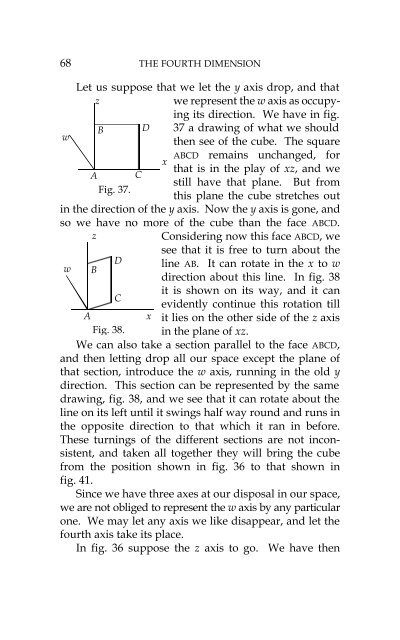You also want an ePaper? Increase the reach of your titles
YUMPU automatically turns print PDFs into web optimized ePapers that Google loves.
68<br />
THE FOURTH DIMENSION<br />
Let us suppose that we let the y axis drop, and that<br />
z<br />
we represent the w axis as occupying<br />
its direction. We have in fig.<br />
B D 37 a drawing of what we should<br />
w<br />
then see of the cube. <strong>The</strong> square<br />
ABCD remains unchanged, for<br />
x<br />
that is in the play of xz, and we<br />
A C<br />
still have that plane. But from<br />
Fig. 37.<br />
this plane the cube stretches out<br />
in the direction of the y axis. Now the y axis is gone, and<br />
so we have no more of the cube than the face ABCD.<br />
z<br />
Considering now this face ABCD, we<br />
see that it is free to turn about the<br />
D line AB. It can rotate in the x to w<br />
w B<br />
direction about this line. In fig. 38<br />
it is shown on its way, and it can<br />
C<br />
evidently continue this rotation till<br />
A<br />
x it lies on the other side of the z axis<br />
Fig. 38.<br />
in the plane of xz.<br />
We can also take a section parallel to the face ABCD,<br />
and then letting drop all our space except the plane of<br />
that section, introduce the w axis, running in the old y<br />
direction. This section can be represented by the same<br />
drawing, fig. 38, and we see that it can rotate about the<br />
line on its left until it swings half way round and runs in<br />
the opposite direction to that which it ran in before.<br />
<strong>The</strong>se turnings of the different sections are not inconsistent,<br />
and taken all together they will bring the cube<br />
from the position shown in fig. 36 to that shown in<br />
fig. 41.<br />
Since we have three axes at our disposal in our space,<br />
we are not obliged to represent the w axis by any particular<br />
one. We may let any axis we like disappear, and let the<br />
fourth axis take its place.<br />
In fig. 36 suppose the z axis to go. We have then






![[PDF] Prolegomena](https://img.yumpu.com/16774951/1/190x245/pdf-prolegomena.jpg?quality=85)









